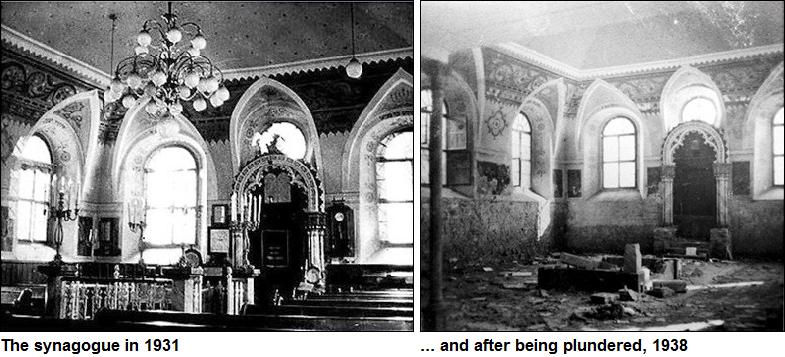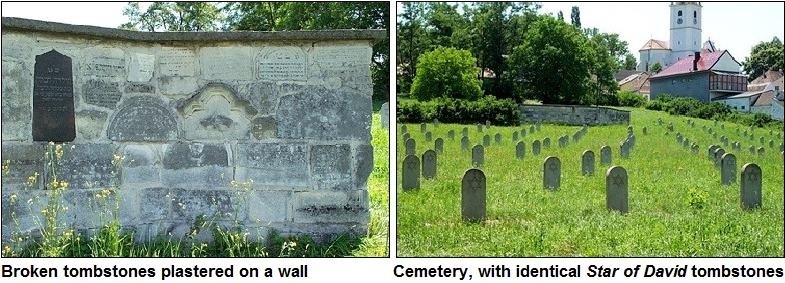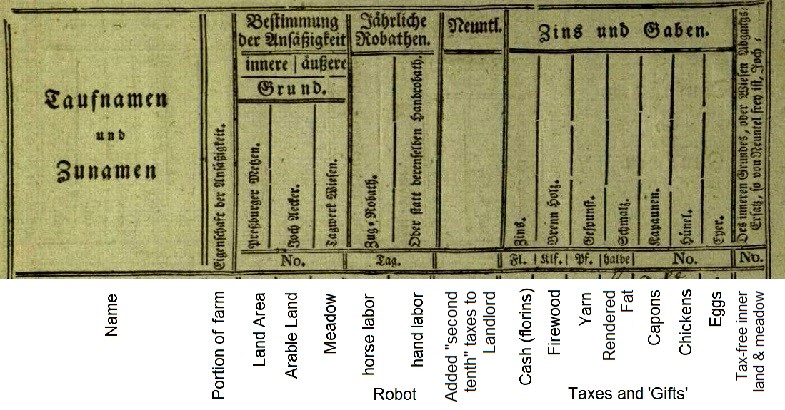|
The
|
|||||||||||||||||||||||||||||||||||||||||||||||||||||||||||||||||||||||||||||||||||||||||||
THE BURGENLAND BUNCH NEWS - No. 257 July 31, 2015, © 2015 by The Burgenland Bunch All rights reserved. Permission to copy excerpts granted if credit is provided. Editor: Thomas Steichen (email: tj.steichen@comcast.net) Archives at: BB Newsletter Index Our 19th Year. The Burgenland Bunch Newsletter is issued monthly online. It was founded by Gerald Berghold (who retired from the BB in the Summer of 2008 and died in August 2008). |
|||||||||||||||||||||||||||||||||||||||||||||||||||||||||||||||||||||||||||||||||||||||||||
Current Status Of The BB: * Members: 2360 * Surname Entries: 7642 * Query Board Entries: 5467 * Staff Members: 17 |
|||||||||||||||||||||||||||||||||||||||||||||||||||||||||||||||||||||||||||||||||||||||||||
This newsletter concerns: 1) THE PRESIDENT'S CORNER 2) JEWISH MATTERSDORF (by Meir Deutsch) 3) KEEPING TRADITIONS ALIVE (by Frank Paukowits) 4) HUNGARICANA TUTORIAL: 1767 URBARIUM 5) THE OSZTOVICS FAMILY STUMP WIDENS (by Joy Minns) 6) HISTORICAL BB NEWSLETTER ARTICLES: - THOSE GERMANIC-HUNGARIAN FAMILY NAMES (from Fritz Königshofer) 7) ETHNIC EVENTS 8) BURGENLAND EMIGRANT OBITUARIES (courtesy of Bob Strauch) |
|||||||||||||||||||||||||||||||||||||||||||||||||||||||||||||||||||||||||||||||||||||||||||
1) THE PRESIDENT'S CORNER (by Tom Steichen)  Concerning
this newsletter, after the bits and pieces here in my "Corner," Article 2 is the piece about
Jewish Mattersdorf (Mattersburg) by Meir Deutsch that I mentioned was
forthcoming last month. Meir draws us a portrait of the "town within a town" and the sometimes
precarious nature of their co-relationship. Concerning
this newsletter, after the bits and pieces here in my "Corner," Article 2 is the piece about
Jewish Mattersdorf (Mattersburg) by Meir Deutsch that I mentioned was
forthcoming last month. Meir draws us a portrait of the "town within a town" and the sometimes
precarious nature of their co-relationship.Articles 3 is by Frank Paukowits and tells the story of a Burgenland emigrant, Ella (Wuits) Mayer, who cherished the dance style known as Schuhplattling and Kept the Tradition Alive by passing it to her daughter and granddaughters. In Article 4, I present a Tutorial article on using the 1767 Urbarium Database found on the Hungaricana website. I'll tell you more about this in one of my bits and pieces below. Article 5 is by Joy Minns, who has written for us before about her Osztovics Family "Stump", one so-called because it has too few branches to be called a family tree! In this article, however, she learns of a new branch... but it wasn't easy! My sincere thanks to the above authors and suppliers of information! Writing and/or editing a monthly newsletter is easy when other people supply articles and ideas... but very tough when I have to do everything. Do consider contributing, whether it be a completed article, a rough draft, or just a topic. I appreciate all contributions! The remaining articles are our standard sections: Historical Newsletter Articles, and the Ethnic Events and Emigrant Obituaries sections.  Church
Names: I mentioned that I had started a campaign a few months ago to identify all
church/temple/synagogue names in Burgenland. This month, BB member Robert Chapman,
of Los Angeles, CA, a researcher of the Wurm surname from Gols (plus quite a few other
surnames from northern Burgenland and the adjacent region in Hungary), wrote in with contact
information and pictures of the churches in Gols. Church
Names: I mentioned that I had started a campaign a few months ago to identify all
church/temple/synagogue names in Burgenland. This month, BB member Robert Chapman,
of Los Angeles, CA, a researcher of the Wurm surname from Gols (plus quite a few other
surnames from northern Burgenland and the adjacent region in Hungary), wrote in with contact
information and pictures of the churches in Gols.Unfortunately, this is more detail than I typically gathered in this identification campaign. These church names are inserted on our Villages pages, where a line or two identifying the churches in a given town does not detract much from the main purpose of the pages, which is to identify BB members with research interest in each village. While I remain interested in adding church name information (or correcting wrong name information), there simply is not room for additional information. I thanked Bob for sharing but also was forced to tell him I had no place for these pictures and details (plus I don't want to start yet another, larger collection of information!).  HUNGARICANA:
Last month I mentioned a new Hungarian site (English main page at
http://hungaricana.hu/en/) that is "the common
website of Hungarian archives, museums and libraries, operated by the Hungarian Library of
Parliament (Országgyűlési Könyvtár)." I also warned that most documents are in Hungarian,
Latin or German... but I failed to mentioned that almost everything beyond the main entry pages
and the documents themselves, including returned results of searches, are in Hungarian. HUNGARICANA:
Last month I mentioned a new Hungarian site (English main page at
http://hungaricana.hu/en/) that is "the common
website of Hungarian archives, museums and libraries, operated by the Hungarian Library of
Parliament (Országgyűlési Könyvtár)." I also warned that most documents are in Hungarian,
Latin or German... but I failed to mentioned that almost everything beyond the main entry pages
and the documents themselves, including returned results of searches, are in Hungarian. BB member Ginger McGurk quickly discovered this and wrote in saying, "Tom, I guess I am not as tech savvy as I need to be. I tried to use the Hungaricana archives and don't really understand how to do it. May we have a tutorial of some sort?" I replied, saying: "I can put together at least a 'partial' tutorial as a newsletter article. The problem with a 'full' tutorial is that each option you pick on the Hungaricana site has its own procedures… the options cover different resources so have different ways to view or search them. Thus your request calls for a specific tutorial for each option." Given what I said above, I've decided to do some monthly mini-tutorials, picking one topic each month and providing enough information to get Ginger (and others) started. But even a mini-tutorial is too long to include in this bits-and-pieces section of the newsletter. Since I find the 1767 Urbarium database to be interesting, I will begin with it. You will find the tutorial elsewhere in this newsletter under title HUNGARICANA Tutorial: 1767 Urbarium. See you there! Do You Have Living Relatives Born in the 1800s?: I doubt it! But if so, those relatives would be over 115 years old and would be well on their way toward setting a new maximum human lifespan record. The documented maximum human lifespan has risen from 103 in 1798 to 122.45 in 1997 (the current record) but scientific researchers say "no fixed theoretical limit to human longevity is apparent today." Statistical modeling and analysis of recent human survival curves predicts a maximum human lifespan of about 125 years, but someone that age will truly be the one-in-a-billion! My musings on this topic was prompted by reading several variations of a news article (one version of which I'll reprint below). The article indicates that an organization that tracks the world's longest-living people says we are down to the last two people that were verifiably born in the 1800s! ...and neither is a Burgenländer! Here is the article:
Church record indices from Lower and Upper Austria, Burgenland, Bohemia and Moravia: approximately 121,000 new entries from Catholic registers have been added. Current coverage of Burgenland villages now include:
Baptismal Index of Vienna between 1585 and 1900: approximately 97,000 new
records, pushing the total to approximately 925,000 records online. |
|||||||||||||||||||||||||||||||||||||||||||||||||||||||||||||||||||||||||||||||||||||||||||
2) JEWISH MATTERSDORF (by Meir Deutsch) Excerpts from book "Yalde Shabat" (= Shabbat Children), Jerusalem 2008, by Meir Deutsch (the book is in Hebrew)  The
township of Mattersdorf (Nagy Marton, in Hungarian) was part of Hungary in the Dual Monarchy. Up
to 1902, there were actually two administrations, the Markt and the Judenstadt (=
Jewish Town). Each of the two administrations had its own Municipality, Police, Court, Jail and
Fire Brigade. The Jewish Fire Brigade continued to function after the union of the two
townships, until the Jews were expelled in 1938. The
township of Mattersdorf (Nagy Marton, in Hungarian) was part of Hungary in the Dual Monarchy. Up
to 1902, there were actually two administrations, the Markt and the Judenstadt (=
Jewish Town). Each of the two administrations had its own Municipality, Police, Court, Jail and
Fire Brigade. The Jewish Fire Brigade continued to function after the union of the two
townships, until the Jews were expelled in 1938.The Jewish community is an old one. On the synagogue, it mentions that it was first built in 1354. In 1496, the Jews were expelled from Mattersdorf but rebuilt the community again in 1527, after they were expelled from Ödenburg. The growth of the community started in 1670, after Leopold I expelled the Jews from Vienna, but this was very short-lived. Just a year later, in 1671, they were expelled again and settled in Moravia. The Jews returned to Mattersdorf in 1678 and had to repurchase their own homes. At the end of the 17th century, they got the protection of the Esterházy, but they had to pay high taxes levied on them for this protection. 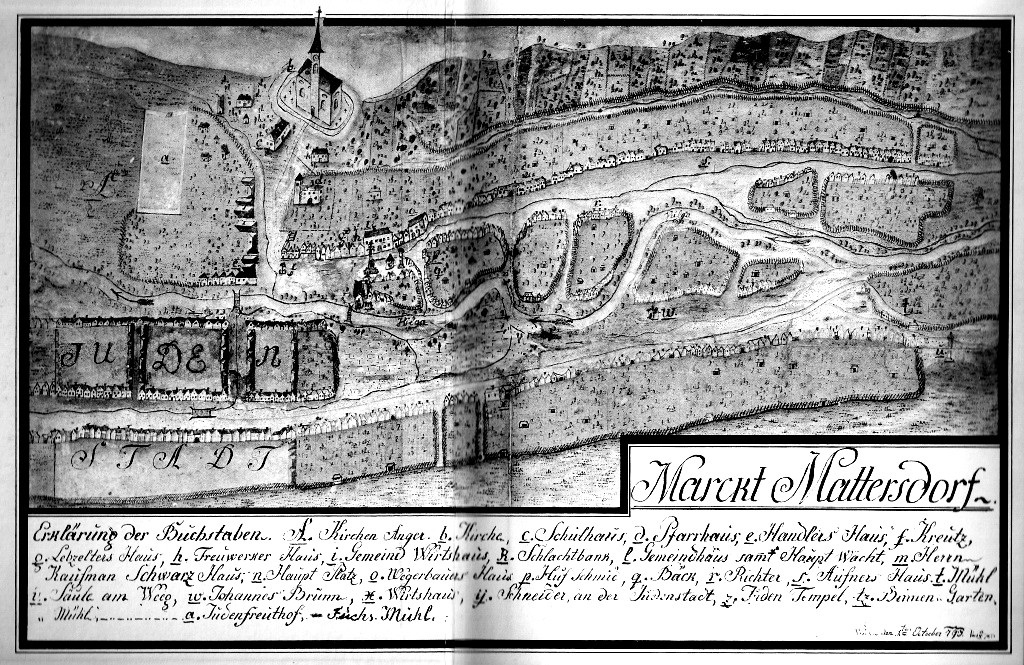 The Judenstadt of Mattersdorf, on the lower-left of a 1798 map Mattersdorf was a member of the seven Jewish communities in Burgenland: Kittsee, Eisenstadt, Mattersburg, Frauenkirchen, Kobersdorf, Lackenbach and Deutschkreutz (known as Zelem by the Jews). These seven communities were joined later by another three in the South Burgenland: Stadtschlaining, Rechnitz and Güssing. The Synagogue was the center of Jewish life of the Jewish community. From the street there were two entrances to the Synagogue, one for ladies and a second one for men. In the entrance hall there were a cupboard for the use of the shames (= caretaker) and the chair of Elyahu, better known as "the big chair of the Mohel." The synagogue's treasury was rich with valuable antique objects: Goblets, Torah shields and Torah crowns, all from the 16th and 17th century, and two Holy Ark curtains from the 17th century, both woven with gold threads, and one from the 13th or 14th century, woven with silver threads. 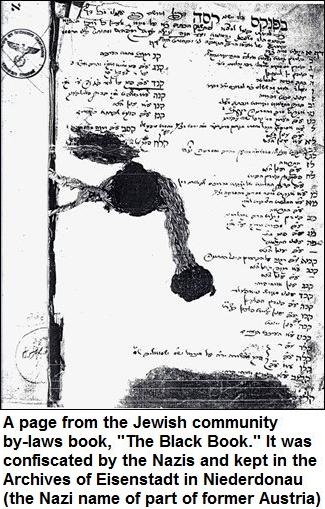 Next
to the Synagogue was the Town Hall of the Jewish community. In this building, the meetings of
the community took place, the communal laws were adopted and the court had its sittings. In one
of its wings was the "Hekdesh" that served the poor and the sick. In the town's registry,
the building was described as "the Town Hall and Hospital." Next
to the Synagogue was the Town Hall of the Jewish community. In this building, the meetings of
the community took place, the communal laws were adopted and the court had its sittings. In one
of its wings was the "Hekdesh" that served the poor and the sick. In the town's registry,
the building was described as "the Town Hall and Hospital."As said, Mattersdorf was a twin township, a Christian one and a Jewish one. Both congregations had complete independence but co-operated with each other. The Gentiles saw the "Eruv", a three meters high wire that defined the “private domain” wherein carrying of objects by Jews was allowed on Sabbath and Yom Kippur, as the line that separated the two municipalities. As most of the Christian inhabitants were farmers and fruit growers, and the Jews mostly shopkeepers and small manufacturers, the Jewish fire brigade was usually the first to get to the fire in town and even in the neighboring villages. They got many commendations for their work and dedication. According to the law, if a Gentile or a Jew had a claim against a Jew, the case was brought before the Jewish Judge and vice 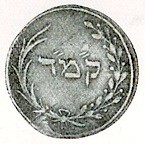 versa.
Up to the year 1848 the Jewish community minted its own coin, called a "fleischkreutzer."
Because of lack of funds of the Jewish community, this dual township ceased in 1903 and the two
municipalities were united. versa.
Up to the year 1848 the Jewish community minted its own coin, called a "fleischkreutzer."
Because of lack of funds of the Jewish community, this dual township ceased in 1903 and the two
municipalities were united.The Jewish population grew up to the middle of the nineteenth century; afterwards, many families settled in neighboring communities and, in the twentieth century, many moved to the larger cities. The census of 1569 of Mattersdorf recorded 62 Jews who dwelled in 11 houses. In 1857 – 954 Jews out of a total population of 3265 (29.2%). In 1923 – 450 Jews out of a total population of 3706 (12.1%). In 1934 – 511 Jews out of a total population of 5112 (10.0%). The distribution of the Jewish male population in 1811 was as follows: Ages 1 to 17: 183 Ages 17 to 40: 127 (Married: 97; Single: 30) Over Age 40: 118 In the nineteenth century, there were censuses that reported the proportion of German-speaking population. Mattersdorf was part of the Hungarian Kingdom of the Habsburg Empire with Ödenburg (Sopron in Hungarian) as the county's capital. In the majority of schools, both languages were used. From those censuses, the proportion of German-speaking Jewish people in Ödenburg County were: In 1830 – Males 84.1%; Females: 45.9%. In 1850 – Males 99.3%; Females: 91.6%. What we see here is that, although the county was part of Hungary, nearly all the Jewish inhabitants spoke German. The Jewish population of Mattersdorf was restricted in building new dwellings beyond the fifty houses they owned (thirty-eight existed in 1816 and twelve were built in 1819). Up to 1819, they were also forbidden to rent houses from the Christian population. On the other hand, a person could marry only if he owned a dwelling. As said, in 1819 the Jews were permitted to build the additional houses, outside the ghetto, and they were called Neuhausel (new houses). Just for comparison, in 1845, in the whole of Mattersdorf, there were only 283 houses. Because of these restrictions, the Jewish population suffered from overcrowding. We can see that, in 1724, there were twenty-four owners of a whole house, twelve owners of half a house and nine owners of one third of a house. The total number of houses owned by Jews was thirty-two. Fourteen years later, in 1738, there were twenty-five owners of a whole house, nine owners of half a house, and ten owners of a quarter of a house. In total, the Jews inhabited thirty-two houses. Just six years later, in 1744, we find only seventeen owners of a whole house, two owners of three-quarters of a house, twenty-one owners of half a house, twelve owners of a quarter of a house and two owners of one-sixth of a house. In total, they lived in thirty-three houses. As the time passed, the crowding increased. In 1760, we find only seven who owned a whole house, one owner of seven-eighths of a house, two owners of three-quarters of a house, thirteen owners of half a house, two owners of two-fifth of a house, and others with much smaller parts, amongst them two that owned only one-sixteenth of a house. The problem of overcrowding can be seen from the will of Elyakim ben Avraham Leib that was signed on the 2nd of February 1817 before Salomon Rosenfeld as witness and Simon Deutsch as Notary, which includes the following paragraph: "If the kitchen has to be divided, it will be divided in a way that each part could put in it a baking oven." The distribution by profession of the Jews was, in 1754, as follows: 6 tailors, 16 merchants, 2 furriers, 15 shopkeepers, 8 teachers, 16 winemakers, 3 beer brewers, one musician, 6 grocers, one shoemaker, one barber, one waiter, one singer, one locksmith and one bookbinder. As there was no building for a school, the lessons were given in the Synagogue and, later, in private houses. The first school building was built only in 1883. Beside the school there was also a College of Talmud (Yeshiva), whose majority of students came from out of town. The records show that, already in the reign of Empress Maria Theresa (1717-1780), there was a state Jewish school in Mattersdorf with many students. Maria Theresa had launched plans for compulsory primary education in Austria-Hungary, whereby all children of both genders from the ages of six to twelve had to attend school. There was much attention given to education in Jewish Mattersdorf. In 1873, there were, in the Jewish school in Mattersdorf, a hundred and thirty students aged six to twelve in three classes, out of them, seventy-six boys and fifty-four girls. There were three teachers who taught them. If we compare the ratio of students to teachers, we find a ratio of forty-three pupils to one teacher in the Jewish school as against ninety-three pupils to one teacher in the Christian school. We can deduce from it that the education in the Jewish school was superior to the Christian one. In addition to the elementary school, there were also higher grades in the Jewish school, which included eleven boys and six girls aged twelve to fifteen. We can see from the pupils attending the Jewish school that the education of girls was an integral part of the education system in Jewish Mattersdorf already in the nineteenth century. The number of female pupils in the Jewish school in Mattersdorf was nearly as great as that of the males. The Talmud College (Yeshiva) was known as one of the best in the Habsburg Empire. The Chatam Sofer (Rabbi Moses Schreiber, a former Chief Rabbi of Mattersdorf and later in Pressburg) used to say: "Rabbinical studies are to be learned in Mattersdorf." Not everybody was accepted to the College. Anyone who wanted to be accepted had to prove his ability to master the learning. The two communities, the Christian and the Jewish lived together in harmony. There was not much competition between them as the Christian community members were usually farmers and wine and fruit growers and the Jews were manufacturers and shopkeepers. It was said that the priest delivered a speech one day in which he accused that: "the Mattersdorf Jews have killed our savior." The head of the Christian community came to see the head of the Jewish community and asked him: "Dear friend, what can you say in defense of the priest's accusation?" The head of the Jewish community replied calmly: "It was not us; they were from Kobersdorf (a nearby township)." The head of the Christian community, who knew that the Mattersdorf Jews were not violent, was satisfied with the answer, and peace between the two communities was restored again. As Jews do not play musical instruments on their holy days, the music was taken over by the Gentile population. On Simchat Tora, a Jewish holy day, as the community escorted the Rabbi from the synagogue to his home, the Gentile community joined the procession and played the music. But not everything went smoothly in Mattersdorf. During the first half of the eighteenth century there were many calamities in the congregation. In 1831, there was a cholera epidemic in the Jewish township. It was brought in, probably, by a Jewish family of eight people that came from Baden, and that despite them being in isolation for eight days. On the 27th of September 1831, when the epidemic started, about one hundred and fifty people got infected and twenty-seven died. The Jewish township was put under isolation up to the 14th of October. The Christian population raised money to supply the Jews with bread, flour, potatoes, wood for heating and money. 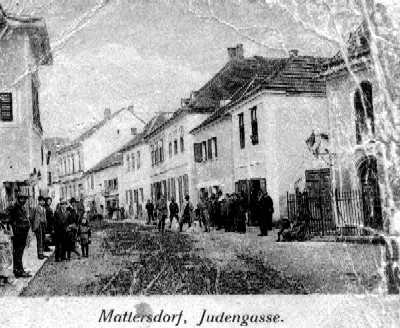 In
1810, after the burning down of fifty-six houses in the Christian township, the Jewish
population donated money to help their neighbors. In
1810, after the burning down of fifty-six houses in the Christian township, the Jewish
population donated money to help their neighbors. There were also other large fires which caused heavy damage. The fire of 1802 burned down thirty-two Christian houses and thirty-two Jewish houses. Another fire, that started out in the Christian Township in 1837, spread to the Jewish Township and destroyed many houses. Yet another fire, on the night between the 7th and 8th of July 1853 at the house of Abraham Koppel, burned down thirty-five houses in the Judengasse and affected seventy-seven families. Running a business needed capital. The capital had to be raised and repaid. From a document of 1817 we see one such transaction:
The amount of 21,700 fl. was a very large sum. Just for comparison: in 1812, the price of a
sheep was 2 fl. and the price of a milk-giving cow was 15 fl.
Dr. Richard Berczeller was the Jewish Medical Doctor in Mattersburg. He studied
medicine at the University of Vienna and was a resident physician there. When the Jewish Doctor
of Mattersburg, Dr. Max, died, the community approached Dr. Berczeller to take his place. Dr.
Berczeller took a leave of absence from the Viennese Hospital and moved temporarily to
Mattersburg. The times were hard for him. He had a few clients from the Christian population,
but only one Jewish patient, Mrs. Zonnenstein. One day a Talmud student came to his
clinic and asked him to come and pay a visit to the house of Rabbi Zobelman, the head of the
Rabbinical College. When they arrived at his home, Dr. Berczeller asked the Rabbi: "What is
wrong and why was I called?" The Rabbi said: "You are the physician; you tell me what is
wrong with me." After a thorough examination the doctor could find nothing wrong with the
Rabbi, except that he had "flat feet." After the doctor's findings, the Rabbi told him that he
agreed -- but told the young doctor that the population was used to Dr. Max, who served for over
fifty years, and could not yet absorb the fact that there was a young new doctor. The story that
the physician visited the Rabbi spread around the city and the Jewish population started
visiting the clinic of Dr. Berczeller. |
|||||||||||||||||||||||||||||||||||||||||||||||||||||||||||||||||||||||||||||||||||||||||||
3) KEEPING TRADITIONS ALIVE (by Frank Paukowits) Gloria McSweeney, BB member, has a wonderful story about her mother and family that she thought would be appropriate to share with the group. 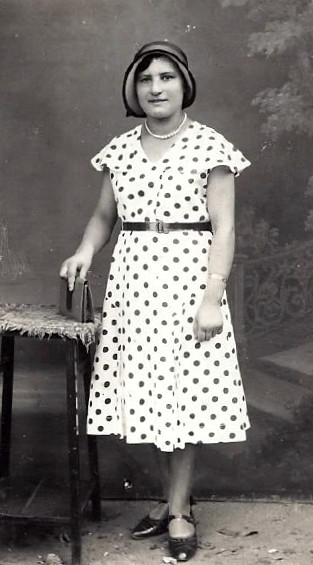 Next
year will mark the 100th anniversary of the birth of Angela (Ella) Mayer (neé Wuits) from
Markt Neuhodis, a small town in the Oberwart district of Burgenland. Ella was one of eight
children. There were seven girls and one boy in the family. All but three stayed in Burgenland.
The parents were long-time residents of the town and worked a small farm for their livelihood.
As for many of the inhabitants, life was not easy for the Wuits family at that time. Next
year will mark the 100th anniversary of the birth of Angela (Ella) Mayer (neé Wuits) from
Markt Neuhodis, a small town in the Oberwart district of Burgenland. Ella was one of eight
children. There were seven girls and one boy in the family. All but three stayed in Burgenland.
The parents were long-time residents of the town and worked a small farm for their livelihood.
As for many of the inhabitants, life was not easy for the Wuits family at that time.In 1934, at the age of eighteen, Ella left her home for a new beginning in America. It was a trek like thousands of others had made who traveled from their homeland to better their lives in a new and promising place. All they brought with them were strong hands, an unrelenting work ethic, and core religious beliefs that served to guide their lives. What makes this story different from others is the strong music and dance tradition from Austria/Germany that Ella introduced to her family. Her love of Schuhplattling not only was instilled in her daughter, Gloria, but also in her granddaughter and great-granddaughters... four generations in total, spanning nearly eighty years. Ella’s sister, Maria, and Maria's husband Alois immigrated to the United States a couple of years prior to Ella’s arrival from Burgenland. Maria sponsored Ella and they lived in New York City. The two sisters worked for a wealthy family; Maria was the cook and Ella was the au pair. The Depression years were tough times but, in spite of the difficulty, they always sent money back to their family in Burgenland, who also were in need of financial help. 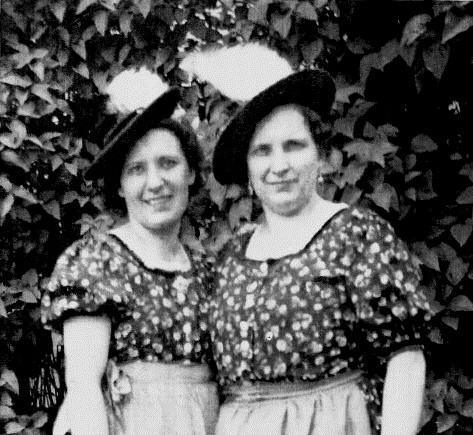 In
the mid 1930s, Ella, Maria and Alois joined the “Original Schuhplattler V.V. Enzian” (Original
Enzian) which was founded in 1922. At their annual Bauernball in Yorkville in 1938,
Ella met her future husband, Maximilian (Max) Mayer; they married in 1941. Max had immigrated to
the United States in the mid-1930’s from Westerndorf, St. Peter, a hamlet of Rosenheim in
Bavaria. Both he and his brother Sebastian had left their homeland to make a better life for
themselves. In
the mid 1930s, Ella, Maria and Alois joined the “Original Schuhplattler V.V. Enzian” (Original
Enzian) which was founded in 1922. At their annual Bauernball in Yorkville in 1938,
Ella met her future husband, Maximilian (Max) Mayer; they married in 1941. Max had immigrated to
the United States in the mid-1930’s from Westerndorf, St. Peter, a hamlet of Rosenheim in
Bavaria. Both he and his brother Sebastian had left their homeland to make a better life for
themselves. Ella got Max interested in Schuhplattling so both he and Sebastian joined the Original Enzian. In 1947, after moving from New York City to Westchester County, they joined Bavarian Club Edelweiss, Westchester. Ella was the heart and soul of the Club. She 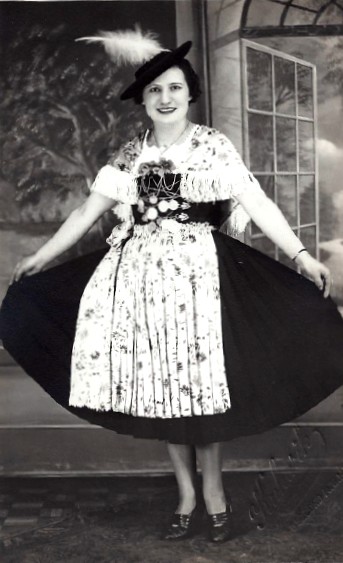 became
the unofficial ”matchmaker” of the group, pairing many couples together as lifetime mates. She
was also Vortänzerin (lead woman dancer) for eighteen years. became
the unofficial ”matchmaker” of the group, pairing many couples together as lifetime mates. She
was also Vortänzerin (lead woman dancer) for eighteen years. Ella continued dancing with the Club until she unexpectedly passed away at the age of 62 in 1979 at the seventh Gaufest in Los Angeles. Max died seventeen years later at the age of 87. Their daughter Gloria picked up the mantle and continues to keep her parents' love of dancing, customs and heritage alive. She has been dancing since she was a little girl. Her daughter Lisa and granddaughters, Alessandra and Isabella, were only a little more than toddlers when they were first exposed to the world of Schuhplattling. One granddaughter, Isabella, was a Junior Princess at the annual German-American Steuben Parade in 2009. Eight years ago, Gloria became the first female President of the Bavarian Club Edelweiss, Westchester, the club that her parents were members of for over thirty-five years. The Club presently has over 140 members. 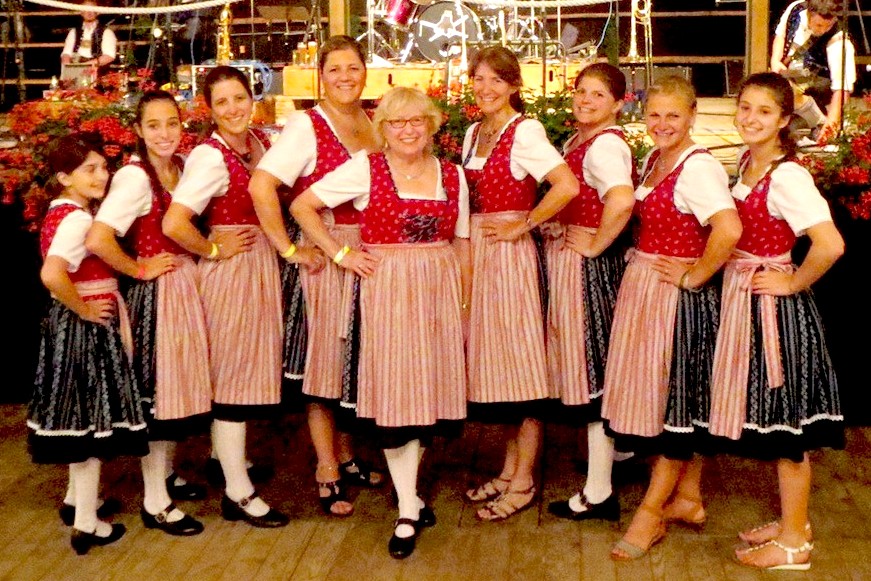 The generations: daughter Gloria (middle); granddaughter Lisa Caico (third from left), great-granddaughters Alessandra Caico (second from left) and Isabella Caico (last person on right). Gloria says that dancing in the same club that her parents were members of keeps the family connected. She truly believes that her parents are looking down from heaven with smiles on their faces knowing that the Schuhplattling tradition started by them is being kept alive by the generations that have followed them! |
|||||||||||||||||||||||||||||||||||||||||||||||||||||||||||||||||||||||||||||||||||||||||||
4) HUNGARICANA TUTORIAL: 1767 URBARIUM 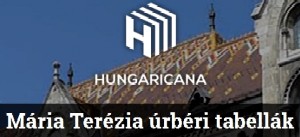 The
1767 Urbarium database, found at
http://archives.hungaricana.hu/en/urberi/, is one of the many resources on the
HUNGARICANA website (English main page at
http://hungaricana.hu/en/). Like other resources on the site, much of the operational
information is presented in Hungarian, though there are a few initial pages in English. In
addition, the original Urbarium is mostly in hand-written Latin, which adds to the
complexity of using this resource. The
1767 Urbarium database, found at
http://archives.hungaricana.hu/en/urberi/, is one of the many resources on the
HUNGARICANA website (English main page at
http://hungaricana.hu/en/). Like other resources on the site, much of the operational
information is presented in Hungarian, though there are a few initial pages in English. In
addition, the original Urbarium is mostly in hand-written Latin, which adds to the
complexity of using this resource.We begin by clicking the first link above, which should take you to a page that includes the logo I have inserted in the upper-right corner of this article. The initial page also includes a description of the database plus multiple ways to find data relevant to you. As the description notes, "the tables contain the names of the squires, villeins and cottars," that is, the tax-paying residents of the villages. Since Ginger McGurk was the motivation for these tutorials, and since one of her villages of interest is Apetlon, where she has Klein ancestors, I will use that village and that surname as the tutorial example. The first thing you must note is that the German name (Apetlon) for this village is probably not relevant... but it might be! More likely, the village will be identified by its Hungarian name, Bánfalu, or some variation on that (you can find the Hungarian name on the BB's Villages pages, and you should do that before starting with the Hungaricana pages). Please do not expect that every village name will be spelled exactly like we spell them currently! I have found some that differ so greatly from any modern spelling that they are effectively unidentifiable without help from experts. In the case of Bánfalu (and similarly-named villages), a common variation is the substitution of the equivalent falva for falu (both meaning village), giving Bánfalva as the village name. Also, be aware that many village names were duplicated in other Hungarian counties... this makes searching for the one you want much more frustrating and difficult... it is often far better to use a 'direct' approach rather than the Search box tool (as tempting as that might be). Thus, even though the Urbarium database is quite straightforward and the Search box works reasonably well, I will first show all three ways to find the data that is relevant to you before moving to and describing the actual Urbar data (I do that description in what I call the "Results" section below). These three ways are the Search box, the 'direct' Contents approach, and the Map approach. Finding your Village Data, Option 1: Search Box Approach So, let's start with the Search box near the top of the page. Start by typing in banf (capitalization does not matter)... you will see that a list of keyword hits appears below the box... and none are banfalu or banfalva! If you paid attention, you will note that I ignored the accent mark on the 'a' when I told you to type banf... unfortunately, the Search box is sensitive to the presence or absence of accent marks and umlauts... you  must
type bánf. Doing so will show bánfalva as the second keyword, with 3 hits noted
for it. You can either type the rest of this word or click on it in the keyword list. Now click
the little magnifying glass at the right end of the search box to initiate the search. must
type bánf. Doing so will show bánfalva as the second keyword, with 3 hits noted
for it. You can either type the rest of this word or click on it in the keyword list. Now click
the little magnifying glass at the right end of the search box to initiate the search.This will return a list of the three hits found for keyword bánfalva, among them, one labeled 2. Bánfalva (MOSON). As I mentioned above, village names were not unique in Hungary. In fact, there are three Bánfalvas in Hungary, one each in counties Borsod, Moson and Trencsén. Because of this, the county name is often pre-pended to the village name, creating a unique name such as Mosonbánfalva. We list names of this form on our Villages pages when we are aware of a possible conflict. Regardless, you must know the old Hungarian county that applies to get the right data. 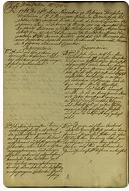 For
Burgenland, these county names would be Moson, Sopron or Vas, with Moson
the applicable one for Apetlon/Bánfalva. For
Burgenland, these county names would be Moson, Sopron or Vas, with Moson
the applicable one for Apetlon/Bánfalva.To get to the Apetlon/Bánfalva specific pages, you can click on the hyperlinked text, 2. Bánfalva (MOSON) or on the thumbnail image (like the image to the right of this paragraph) of the first Urbar page. Continue with the instructions in the Results: section of this article. Finding your Village Data, Option 2: Contents Approach 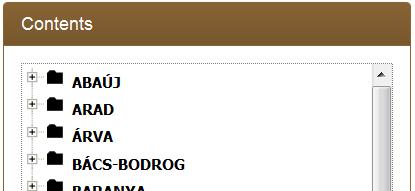 In
"Option 1" we chose to use the Search box to find the Apetlon pages. However, from
the initial 1767 Urbarium database page, found at
http://archives.hungaricana.hu/en/urberi/,
we could have taken a different approach. Just below the database description on that initial
page and on the right edge of the display is a Contents section listing the
counties of Hungary. If you go to that section, then roll down to Moson county and click
the plus-sign beside the county name, it will open a list of villages within the county.
Bánfalva is the second village listed. Click on that village name and you will immediately
open the Apetlon/Bánfalva initial page and will be at the point I mark as "Results:"
below... and you won't have to deal with typing accented special characters! In
"Option 1" we chose to use the Search box to find the Apetlon pages. However, from
the initial 1767 Urbarium database page, found at
http://archives.hungaricana.hu/en/urberi/,
we could have taken a different approach. Just below the database description on that initial
page and on the right edge of the display is a Contents section listing the
counties of Hungary. If you go to that section, then roll down to Moson county and click
the plus-sign beside the county name, it will open a list of villages within the county.
Bánfalva is the second village listed. Click on that village name and you will immediately
open the Apetlon/Bánfalva initial page and will be at the point I mark as "Results:"
below... and you won't have to deal with typing accented special characters! Continue with the instructions in the Results: section of this article. Finding your Village Data, Option 3: Map Approach This is an approach I do not recommend, as it can be confusing and the Search box and Contents approaches are far easier. However, for completeness I'll explain it. 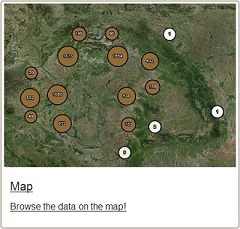 Again,
we start from the initial 1767 Urbarium database page, found at
http://archives.hungaricana.hu/en/urberi/.
On that page, to the right of the database description, is a Map of Hungary. Click
on the map itself, the word Map below it, or the text that says "Browse the data on
the map". Again,
we start from the initial 1767 Urbarium database page, found at
http://archives.hungaricana.hu/en/urberi/.
On that page, to the right of the database description, is a Map of Hungary. Click
on the map itself, the word Map below it, or the text that says "Browse the data on
the map". This will bring up a bigger map of Europe with the Second Military Mapping Survey overlaying Hungary. This Survey map is actual a nuisance here and must be turned off, at least initially. You do that by clicking the Layers control in the upper right corner of the map and then clicking the "None" button in the "Historical Layers" section. Alternatively, you can leave the Survey map selected but fade it using the slider right under the words "Historical Layers." You do this by grabbing the blue section with your mouse and sliding it to the left, say to about 20%. That way, you can use the modern map to guide you to the village you want. After doing one of these (eliminating or fading the Survey map), click on the Layers control again to get rid of the layer options. Now start zooming in to the Vienna/Bratislava area, as Apetlon is below and between these larger cities. You can use your mouse wheel or the blue "plus" button in the upper-left of the map to do so. As you zoom further, you will start to see the Neusiedlersee. Apetlon is to the right of the lake and near the bottom of it. Play around with the map, dragging right or left, up or down, and increasing the zoom until you find Apetlon. Once you find it, click on the numbered circle that will appear over the village. Clicking it will bring up a pop-up window that will have the word Bánfalva on it. Click the word. Continue with the instructions in the Results: section of this article, immediately below. Results:
Any of the above approaches will display the initial Apetlon/Bánfalva specific page. It will show a thumbnail image of the first Bánfalva Urbar page, a map, and a small data set like this:
In the above data set, Name is that of the village owner in 1767. Telek reports
the number of "whole" farms in the village and Hold is the total area of the land, as
measured in holds. Jobbágy is the count of farmers/serfs, Zsellér is the
count of craftsmen/cottars (they own a house and a token bit of land), and Házatlan is
the count of those in the village who own neither land or a home (they are hired hands who work
for farmers and live with them). Given this village has 151 farmers and only 71 whole farms, it
should be clear that smaller land holdings are common in the village.
|
|||||||||||||||||||||||||||||||||||||||||||||||||||||||||||||||||||||||||||||||||||||||||||
5) THE OSZTOVICS FAMILY STUMP WIDENS (by Joy Minns) This past February, I received an e-mail which totally confused me. The sender, Herr Christian Wallner, said he lived in Antau, Austria, and he was answering my e-mail, which had been forwarded to him by his parish priest. I had no recollection of ever sending such an e-mail to Antau and had no clue as to why I would do such a thing! So it took a while for me to realize what was going on... When I was searching through the Catholic Church archives in Eisenstadt in 2013, I asked a worker there if he had any information on priests with the last name Osztovics. I had expected to be handed information on my uncles, Stefan and Josef. Instead, I was given an obituary for a Ferencz Osztovits, who was born in Budapest. I pushed it aside, assuming that anyone born in Budapest would be, at best, a distant relative. Arriving home, I decided to pursue the case of Father Ferencz. He had served in Weiden bei Rechnitz and Antau so I wondered if, perhaps, he had served in Burgenland because he had family roots there. I wrote to the church in Antau in October 2013 to get more information on this priest, but received no reply. As time went by, I totally forgot about the contact I had tried to make. Let's return to 2015... The e-mail came from a man whose mother, Dora Wallner, had been raised by an aunt, Maria Endl, who was the housekeeper in the rectory of the parish priest. When Dora grew up, she also took on duties as cook and housekeeper. For some totally unknown reason, Dora had “inherited” the papers of Father Ferencz. She had her son ask me for my mailing address because she wanted to send the papers to me, assuming I was a relative of the priest! 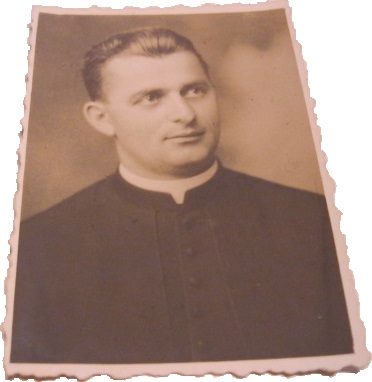 About
a month later, a package arrived in the mail. It contained pictures of Ferencz
administering First Communion, had his passport, his driver’s license, his excuse from military
service during World War II, and other odds and ends. Father Ferencz bore a striking
resemblance to others in my family but, with about 100 Ferencz's in my family notes, I had no
clue where to start my search. The obituary did not list the names of Ferencz’s parents.
I e-mailed Mr. Wallner and he said his mom would “ask around.” In a few weeks I heard
that Ferencz’s mom was named Olga Habetler. This name turned out to be wrong...
but it was a start. Another bit of information that I later discovered was wrong was the birth
date listed in the obituary. About
a month later, a package arrived in the mail. It contained pictures of Ferencz
administering First Communion, had his passport, his driver’s license, his excuse from military
service during World War II, and other odds and ends. Father Ferencz bore a striking
resemblance to others in my family but, with about 100 Ferencz's in my family notes, I had no
clue where to start my search. The obituary did not list the names of Ferencz’s parents.
I e-mailed Mr. Wallner and he said his mom would “ask around.” In a few weeks I heard
that Ferencz’s mom was named Olga Habetler. This name turned out to be wrong...
but it was a start. Another bit of information that I later discovered was wrong was the birth
date listed in the obituary.The BB's Tom Steichen assisted me along the way ...but we were stumped. Then I became aware of a critical error that was hindering our search: ![Passport with correct birthdate: 13 VI 1909 = 13 June 1909 [the obituary had the month as September]](257/Father_birthdate.jpg) I
noticed a different birth date on the passport and driver’s license. We decided to search in
District X (10) of Budapest with the new, hopefully correct, birth date, as that is where
Father Ferencz visited a niece. His civil birth registration popped up immediately with
the names of his parents—another Ferencz, of course—and Anna [not Olga]
Habetler. The ages of the parents were also given. With this information, I went back to my
family notes. I found a Ferencz Osztovics who was born around 1874 ...but he had married
an Anna Unger, not Anna Habetler. This couple had a child named Irma in
1901. One interesting fact was listed, however: Irma’s birth record said that her dad
lived in Budapest but was from Sirokány (Allersgraben), my grandparents’ home town. I
noticed a different birth date on the passport and driver’s license. We decided to search in
District X (10) of Budapest with the new, hopefully correct, birth date, as that is where
Father Ferencz visited a niece. His civil birth registration popped up immediately with
the names of his parents—another Ferencz, of course—and Anna [not Olga]
Habetler. The ages of the parents were also given. With this information, I went back to my
family notes. I found a Ferencz Osztovics who was born around 1874 ...but he had married
an Anna Unger, not Anna Habetler. This couple had a child named Irma in
1901. One interesting fact was listed, however: Irma’s birth record said that her dad
lived in Budapest but was from Sirokány (Allersgraben), my grandparents’ home town.I guess that Tom can’t resist a mystery either. He found the critical link, the marriage record of Ferencz Senior to Anna Habetler in 1907. This Anna was also from the Burgenland: Bándol (Weiden bei Rechnitz). So far we’ve found records for two of their children, Father Ferencz, in 1909. and an older sister, Maria, in 1908. I suspect there were more children because Dora wrote to me that Ferencz had a nephew in Budapest with surname Osztovits (so there has to be a brother to Ferencz). Anyone want to guess what the nephew’s first name was? Ferencz! I wrote an earlier article about my family tree, which I called a stump, as it has very few branches. Much to my surprise, I’ve learned that Father Ferencz is my second cousin once-removed and is also a more distant cousin several other ways. I guess the moral of the story is that someone can seem to be totally unconnected to family in Burgenland but can turn out to be a close relation! |
|||||||||||||||||||||||||||||||||||||||||||||||||||||||||||||||||||||||||||||||||||||||||||
6) HISTORICAL BB NEWSLETTER ARTICLES Editor: This is part of our series designed to recycle interesting articles from the BB Newsletters of 10 years ago. This one comes from Newsletter #142 (July 31, 2005) and speaks mainly about surnames derived from apparent ethnicity/place of origin. THE BURGENLAND BUNCH NEWS No. 142 July 31, 2005 THOSE GERMANIC-HUNGARIAN FAMILY NAMES (from Fritz Königshofer) Matt Boisen poses the following questions to Fritz Königshofer: My great-grandfather, Franz Boehm, was born in Redlschlag in 1846. The Boehms were/are German-speaking Catholic peasants in that area. Since the family name "Boehm" indicates someone from Bohemia: 1. What is the most likely possibility of its origin: were they German Bohemians or were they Czechs who migrated to Hungary? 2. When did Bohemians migrate to this area: before or after the Thirty Year's War, or more recently? 3. Was that part of Hungary considered Protestant in the majority? Fritz replies: Your questions required some reflection in order for me to answer them. Since many ethnicities lived relatively close together in Middle Europe, all languages there have formed last names to describe persons from these other ethnicities. You are right, Böhm or Böhmer would be the last name of a person who, in a German speaking environment, was known (at a time when last names were formed) to have come from Bohemia. Other similarly-formed German last names are Unger, Bayer, Türk, Krobath, Krainer or Schweitzer. In comparison, Hungary formed the last names Németh (the German), Horváth (the Croat), Tóth (the Slovak or the Slovenian), Racz (the Serb), Török (the Turk), Lengyel (the Pole), and similar, and so did other languages present in the region. My theory is that these names were given to single people who stood out in their new communities as "foreigners." Therefore, I would not believe that a name like Böhm was given wholesale to all inhabitants of a new settlement of "immigrants." Rather, these were individuals in (for them) new communities. I remember, in my high school class in Graz, Austria, we had a fellow student who had been born in then Czechoslovakia. Over time, we gave him the nickname Chekerl, because of his country of birth. By the way, I was also born in Czechoslovakia, but received my nickname due to my small stature (another way in which about 700 years ago last names were created, refer to Klein, Schmal, and Gross). The famous Styrian poet, Peter Rosegger, described his youth as a tailor apprentice in his home village in mountainous northeastern Styria. His master faced competition by "the Bohemian tailor." This then must have been a craftsman who had come all the way from somewhere in Bohemia trying to make a living in a foreign place (for him) like Styria. Craftsmen often moved around a lot. Perhaps there were many of them in the original group that received the ethnic last names when last names were created. In your case, the only thing one can surmise with some probability is that some way, back in the left (all male) line of your family tree, there was a person who originally hailed from Bohemia, but had traveled to and settled in an ethnic German environment which was not in Bohemia. Since the population of Bohemia was mostly ethnic German and ethnic Czech (about 50/50), this original receiver of a last name may himself have been ethnic German or ethnic Czech. In the case of the Rosegger story, one would assume that the "Bohemian tailor" was a Czech, whereas my school colleague was from an ethnic German background. In my opinion, it does not matter, anyhow, as this would just be one very long ancestral line of yours which probably, for all successive generations, lived and married in an ethnic German environment (as was Redlschlag and environs). Last names in Middle Europe were mostly formed between about 1250 and 1400. However, in my opinion, an ethnic name like Böhm might still have formed much later, perhaps even until the 1600s, for the reasons I outlined above, especially when the original last name (perhaps being Czech) was too difficult to maintain in the foreign environment. I would venture that, as a result of many generations, you have mostly ethnic "German" blood in your veins and, most likely, more Hungarian and Slovenian blood mixed in than Bohemian. Think of a melting pot. As for your question on religion, the vast majority in Hungary, and equally in former Western Hungary (now Burgenland), were Roman Catholic. However, Lutheranism held on tenaciously during the time of repression of all other creeds in the age of Counter-Reformation. Religious tolerance was eventually decreed in Austro-Hungary in the 1780s. Redlschlag is one of the rather few places in southern Burgenland with a predominantly Lutheran population. Keep in mind in your search that vital events for Lutherans were recorded in the Roman Catholic records until the establishment of religious tolerance and re-creation of Lutheran parishes. To give you an idea of the strength of the various religions in former Vas county of Hungary (when Redlschlag was still part of this county), the census of 1910 recorded 75% Roman Catholics, 20% Lutherans, 3% Calvinists, and 2% Jews. |
|||||||||||||||||||||||||||||||||||||||||||||||||||||||||||||||||||||||||||||||||||||||||||
7) ETHNIC EVENTS LEHIGH VALLEY, PA Sunday, August 2: Annual Parish Picnic at St. Peter's Roman Catholic Church in Coplay. Polka Mass at 10:30 AM. Music by the Emil Schanta Band from 1-5 PM. Sunday, August 23: German-American Day at the Evergreen Heimatbund in Fleetwood. German music, singers (Reading Liederkranz & Lancaster Hobbychor), folk dancers (Auerhahn Schuhplattlerverein), and food. Info: www.evergreenclub.org Sunday, August 23: Summer Dance at the Holy Family Club in Nazareth. Music by the Walt Groller Orchestra. Info: www.holyfamilyclub.com Sunday, August 30: Coplay Community Days at Coplay Community Park. Music by the Walt Groller Orchestra 12-3:30 PM. NEW BRITAIN, CT Friday, August 7, 7 pm: Heimat Abend. Austrian Donau Club, 545 Arch Street, $3. Music by Joe Rogers and his band. Friday, August 21, 7:30 pm: Heurigan Abend. Austrian Donau Club, 545 Arch Street, $3. Music by Schachtelgebirger Musikanten. |
|||||||||||||||||||||||||||||||||||||||||||||||||||||||||||||||||||||||||||||||||||||||||||
8) BURGENLAND EMIGRANT OBITUARIES Juliana Strini (née Mirth)  Juliana
Strini, of Regina, Saskatchewan, Canada, passed away on Saturday, June 27, 2015 at the age of 84
years. She was the wife of Joseph Strini for 61 years. Juliana
Strini, of Regina, Saskatchewan, Canada, passed away on Saturday, June 27, 2015 at the age of 84
years. She was the wife of Joseph Strini for 61 years.Born in Poppendorf, Austria on April 5, 1931, Juliana was the daughter of the late Johann and Anna Mirth. She immigrated to Canada in 1953 to start a new life. Joseph followed in 1954 and they were married. Juliana worked several jobs to help sustain the growing family until she started with Canadian Linen Supply where she worked for 28 years until her retirement. Juliana was mostly inclined to spend her time with family and friends and loved her return visits to Austria to see family and friends left behind after her move to Canada. In the early days she loved to dance and sing old songs with friends. She had a lovely angelic voice. Juliana was involved with the Austrian Canadian Edelweiss Club’s Ladies Auxiliary until her health started to fail shortly after retirement. She was always quick with a smile, outstretched hands and hugs when greeting people. Juliana was happily involved with the Austrian community that also came to Regina to start their new lives. She enjoyed playing cards with the ladies and socializing as well. Survivors: husband; children, Josef and Jimmy; grandchildren, Atira, Jennifer and Jerome; twin sister Cäcilia (Helmuth) Lehmann of New Hamburg, ON; as well as numerous nieces and nephews both in Canada and Austria. In addition to her parents, she was also predeceased by her sister and brother-in-law, Anna and Franz Muthenthaler. Services: a Funeral Mass will be held at Little Flower R.C. Parish, 420 College Avenue, Regina SK on Thursday, July 2, 2015 at 10:30 am. Interment in Riverside Memorial Park. In lieu of flowers, donations in Juliana’s memory may be made to the Canadian Diabetes Association, 917 Albert Street, Regina, SK, S4R 2P6. The family would like to extend a special thank you to Dr. Samir Datta, as well as the many wonderful and caring doctors, nurses and caregivers at both the Regina General Hospital Unit 5E and the Pasqua Palliative Care Unit 3A. Published in The Regina Leader-Post on June 30, 2015 Joseph Gaspar  Joseph
Frank Gaspar, 69, of West Hartford, Connecticut, husband of Orathai (Kayaiwong) Gaspar, died
Friday, June 26, 2015 at Autumn Lake Healthcare in New Britain. Joseph
Frank Gaspar, 69, of West Hartford, Connecticut, husband of Orathai (Kayaiwong) Gaspar, died
Friday, June 26, 2015 at Autumn Lake Healthcare in New Britain. Born in Alsószölnök (Unterzemming/Dolnji Senik), Hungary, he was the son of the late Joseph and Hermina (Gaspar) Gaspar. At the age of ten, Joe escaped with his family during the Hungarian Revolution of 1956 and moved to the United States, settling in Hartford. He was drafted into the U.S. Army during the Vietnam War and served two years in Thailand. After being honorably discharged, he returned to Thailand and worked as a civilian for the next six years with the Department of Defense operating power plants. Joe and Orathai met while working in Thailand and the couple married in 1972. When they returned to Connecticut in 1973, Joe took a position with Terry Steam Turbine in Windsor Locks. The company would eventually become part of Dresser-Rand and Joseph's job took him around the world. He worked in the electrical power generation field in over 20 countries and retired in 2013 due to illness. Joe loved his motorcycle and enjoyed fishing on the Mekong River while in Thailand, and later in life enjoyed walking his dogs. Besides his Orathai, Joe leaves his daughter, Sarah K. Gaspar of Playa del Rey, CA. Orathai and Sarah wished to thank their family, friends, and all those who provided care at Hartford Hospital, Hospital for Special Care, UConn Medical Center, and especially Autumn Lake Health Care, during Joe's extended illness. A private service will be held at the convenience of the family at Fairview Cemetery, West Hartford. In lieu of flowers, those wishing to make an expression of sympathy are asked to consider a donation in Joe's memory to the Wounded Warrior Project, P.O. Box 758517, Topeka, KS 66675; Beacon Hospice, 111 Founders Plaza, Suite 1803, East Hartford, CT 06108; or the Connecticut Humane Society, 701 Russell Road, Newington, CT 06111. Taylor & Modeen Funeral Home, West Hartford has care of arrangements. For online condolences, please visit www.taylorandmodeen.com. Published in The Hartford Courant on July 2, 2015 Karl Leitner  It
is with great sadness, the family of Karl Leitner announces his peaceful passing at home on July
10, 2015, at the age of 85. It
is with great sadness, the family of Karl Leitner announces his peaceful passing at home on July
10, 2015, at the age of 85.He was the beloved husband of the late Helga Maria Louise Heinz. Karl was born in Sopron (Ödenburg), Hungary and emigrated to Canada in 1957. He and his wife worked hard to build a beautiful life for their only son. He was a skilled tradesman, businessman and gentleman-farmer. Karl loved to talk to people, especially young people and he always had a wealth of stories and advice to pass along. He was an avid reader and loved to be outdoors. He enjoyed gardening, travelling and the opportunity to fix anything. He will be greatly missed by his family. Loving father to Michael and his wife MJ. Devoted, proud Opa of Kristy, Mikey and Tomy. Brother of Rudy and the late Lajos. A funeral service will be held at Ward Funeral Home, 2035 Weston Rd. (north of Lawrence Ave. W.), Weston, ON, on Tuesday, July 14th at 11 a.m., followed by interment at Sanctuary Park Cemetery, where he will be laid to rest with his wife. Please visit our Book of Memories at www.wardfuneralhome.com Published in the Toronto Star on July 12, 2015 Pauline Bechtel (née Lang)  Pauline
Bechtel (nee Lang), 96 of Willowick, Ohio, passed away Friday July 3, 2015 in Wickliffe. Pauline
Bechtel (nee Lang), 96 of Willowick, Ohio, passed away Friday July 3, 2015 in Wickliffe.Born May 19, 1919 in Jennersdorf, Austria to the late Joseph and Josephine (Krenn) Lang, she immigrated to Canada when she was 19, crossing the Atlantic on a boat by herself, having the difficult task of assimilating into a new country and language. Pauline lived and worked with her two sisters, who also immigrated to Canada. She met and married William J. Bechtel in Toronto and moving to Cleveland in 1945. She enjoyed cooking, baking, gardening, dancing and listening to polka. One of her favorite pastimes was spending time with her husband and family at their Florida home in Bradenton. She also loved playing bingo and shuffleboard with all her friends in Florida. Pauline was actively involved in her husband's Army 885th Ordinance reunions. She accompanied William to many annual reunions across the U.S. Pauline worked for Reliance Electric in Cleveland for 15 years. Survivors are her loving children Susanna (Herman) Lackner and William J. (Linda) Bechtel Jr.; grandchildren Laura Lackner, Mandy (Fred) Grosse, Tim Lackner, Levi and Dana Bechtel; great grandchildren Tim Lackner Jr. and Nicole Lackner; brothers Eddy (Helen) Lang and Rudolph Lang and spouse; sister-in-law Charlotte Berner (nee Bechtel); nieces Linda (John) Spence and Diana Birkenhier; nephew Phillip Birkenhier. She was preceded in death by her beloved husband of 52 years William J. Bechtel; sisters Gisi (Herman) Schuster and Josie (Peter) Birkenhier; nephew Ronnie (Dorothy) Schuster. The family will be holding a private memorial celebrating Pauline's memory and her long life achievements. Pauline's family wishes to thank the Visiting Angels of Mentor and the Hospice of the Western Reserve for their services. In lieu of flowers, the family suggests contributions in Pauline's memory be made to Hospice of the Western Reserve, 17876 St. Clair Ave. Cleveland 44110. www.jackmonreal.com Published in www.News-Herald.com on July 19, 2015 |
|||||||||||||||||||||||||||||||||||||||||||||||||||||||||||||||||||||||||||||||||||||||||||
| END OF NEWSLETTER |
|||||||||||||||||||||||||||||||||||||||||||||||||||||||||||||||||||||||||||||||||||||||||||
NOTICE (Terms and Conditions): The Burgenland Bunch (BB) was formed and exists to assist Burgenland descendants in their research into their heritage and, toward that end, reserves the right to use any communication you have with us (email, letter, phone conversation, etc.) as part of our information exchange and educational research efforts. • If you do not want your communication to be used for this purpose, indicate that it is "confidential" and we will abide by that request. • Correspondents who communicate with the BB without requesting confidentiality retain their copyright but give a non-exclusive license to the BB allowing us to forward to BB members, publish in our monthly newsletter or on our website, and/or subsequently and permanently archive all or parts of such communications. The Burgenland Bunch homepage (website) can be found at: http://www.the-burgenland-bunch.org Burgenland Bunch Newsletter, copyright © 2015 by The Burgenland Bunch All rights reserved. Permission to copy excerpts granted if credit is provided. |
 News
News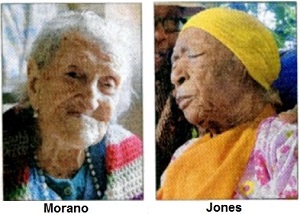 When
Susannah Mushatt Jones and Emma Morano were born in 1899, there was not yet world war or
penicillin, and electricity was still considered a marvel. The women are believed to be the
last two in the world with birthdates in the 1800s.
When
Susannah Mushatt Jones and Emma Morano were born in 1899, there was not yet world war or
penicillin, and electricity was still considered a marvel. The women are believed to be the
last two in the world with birthdates in the 1800s. BB
Houselists and House Number Conversions: A few months ago, I announced that the core of
the BB Houselists project was completed but stated that, "If you have such a list and are
willing to contribute it, we'll be pleased to add it to the collection." I also mentioned
the Old-to-New House Numbers Conversion project.
BB
Houselists and House Number Conversions: A few months ago, I announced that the core of
the BB Houselists project was completed but stated that, "If you have such a list and are
willing to contribute it, we'll be pleased to add it to the collection." I also mentioned
the Old-to-New House Numbers Conversion project.  Islam
in Austria and Burgenland, Follow-up: BB member Rabbi Avrohom Marmorstein, of New
York City, wrote concerning last month's article about the new Austrian Islam Law.
Islam
in Austria and Burgenland, Follow-up: BB member Rabbi Avrohom Marmorstein, of New
York City, wrote concerning last month's article about the new Austrian Islam Law.  Update
for book "The Burgenländer Emigration to America": Here is this month's update on
purchases of the English issue of the 3rd edition of Dr. Walter Dujmovits' book "Die
Amerika-Wanderung Der Burgenländer."
Update
for book "The Burgenländer Emigration to America": Here is this month's update on
purchases of the English issue of the 3rd edition of Dr. Walter Dujmovits' book "Die
Amerika-Wanderung Der Burgenländer." HUNGARIAN
SHORT RIBS (from Bette Votral)
HUNGARIAN
SHORT RIBS (from Bette Votral)
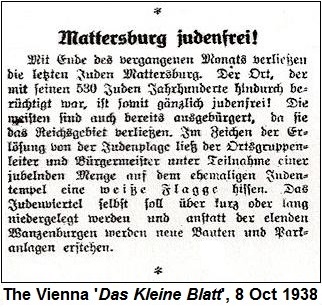 On
the 12th of March, 1938, Austria was incorporated into Germany. The local Nazis went to the
Jewish quarter and started breaking the windows of the Jewish houses. Neighbors that were known
as friends of the Jewish population came out against them. Dr. Berczeller, himself, was arrested
by one of his patients. The Jewish bank accounts were confiscated and the shops, as well as the
Jewish houses, were looted. To save the Torah scrolls, they were taken from the synagogue
and brought to the Shiff-Shul in Vienna, where they later were destroyed when the
Shiff-Shul synagogue was burned down on Kristallnacht (= the night of broken glass).
On
the 12th of March, 1938, Austria was incorporated into Germany. The local Nazis went to the
Jewish quarter and started breaking the windows of the Jewish houses. Neighbors that were known
as friends of the Jewish population came out against them. Dr. Berczeller, himself, was arrested
by one of his patients. The Jewish bank accounts were confiscated and the shops, as well as the
Jewish houses, were looted. To save the Torah scrolls, they were taken from the synagogue
and brought to the Shiff-Shul in Vienna, where they later were destroyed when the
Shiff-Shul synagogue was burned down on Kristallnacht (= the night of broken glass).